Bridging the Gap between Landscape and Management within Marinas: A Review
Abstract
1. Introduction
2. Research Method
2.1. Data Collection
2.2. Screening
2.3. Analysis
3. Results and Discussion
3.1. Main Management Items
| Category | Type | References |
|---|---|---|
| Services | Berthing capacity | [36,37,38,39] |
| Boat handling | [37] | |
| Shipyard and boat storage | [37,39,40,41] | |
| Buildings | [41,42] | |
| Parking facilities | [41] | |
| Auxiliary elements | [41] | |
| Access | [39,40] | |
| Circulation | [41] | |
| Quality of services | [36,39,43,44,45] | |
| Financial | [36,37,38,46,47,48,49,50] | |
| Environmental management | Marine pollutants | [37,38,50,51,52,53,54,55,56] |
| Invasive species introduction | [56,57] | |
| Biological impact (habitat loss) | [47,53,54,58,59] | |
| Seabed alteration | [47,51,57,60,61] | |
| Waste management | [41,51,55,62,63] | |
| Social dimension | [37,38,39,55,64,65,66] | |
| Water quality | [36,54,57,66,67,68,69,70,71,72,73] | |
| Noise level | [66] | |
| Quality environmental certifications | [36,44,66,72,74] | |
| Promotion of nautical fairs | [75] | |
| Relationship with surroundings | [41,45,65,74,75] | |
| Environmental risk | [76,77] | |
| Safety and security | [39,43,78] |
3.2. Landscape Dimension within Marina Management
4. Conclusions
Author Contributions
Funding
Institutional Review Board Statement
Informed Consent Statement
Data Availability Statement
Conflicts of Interest
References
- Council of Europe. European Landscape Convention and Explanatory Report. Document by the Secretary General Established by the General Directorate of Education, Culture, Sport and Youth, and Environment. 2000. Available online: https://rm.coe.int/CoERMPublicCommonSearchServices/DisplayDCTMContent?documentId=0900001680080621 (accessed on 15 May 2016).
- Swanwick, C. Landscape Character Assessment. Guidance for England and Scotland. The Countryside Agency-Scottish Natural Heritage. 2002. Available online: https://www.nature.scot/landscape-character-assessment-guidance-england-and-scotland (accessed on 14 October 2015).
- Martín, R.; Yepes, V. El paisaje en la planificación y gestión de los puertos deportivos en Andalucía. The landscape in the planning and management of marinas in Andalucia. Rev. Obras Públicas 2017, 164, 38–55. [Google Scholar]
- Council of Europe. Recommendation CM/Rec (2008)3 of the Committee of Ministers to Member States on the Guidelines of the Implementation of the European Landscape Convention. 2008. Available online: https://rm.coe.int/16802f80c9 (accessed on 15 May 2016).
- Orams, M. Marine Tourism: Development, Impacts and Management; Routledge: London, UK; New York, NY, USA, 1999. [Google Scholar]
- Luković, T. (Ed.) Nautical Tourism; CAB International: Boston, MA, USA, 2013. [Google Scholar]
- Ugolini, G.M.; Ivaldi, E. Tourist ports and yachting: The case of Sardinia. Rev. Estud. Andal. 2017, 34, 429–452. [Google Scholar] [CrossRef]
- Lam-González, Y.E.; Suárez-Rojas, C.; León, C.J. Factors constraining international growth in nautical tourism firms. Sustainability 2019, 11, 6846. [Google Scholar] [CrossRef]
- Lučić, L.; Luković, T. Controlling as a function of successful management of a marina. Dubrov. Int. Econ. Meet. 2017, 3, 469–479. Available online: https://hrcak.srce.hr/187403 (accessed on 8 November 2020).
- Girard, L.F. Sustainability, creativity, resilience: Towards new development strategies of port areas though evaluation processes. Int. J. Sust. Dev. 2010, 13, 161–184. [Google Scholar] [CrossRef]
- Benevolo, C.; Spinelli, R. Benefit segmentation of pleasure boaters in Mediterranean marinas: A proposal. Int. J. Tour. Res. 2021, 23, 134–145. [Google Scholar] [CrossRef]
- Bonadonna, A.; Rostagno, A.; Beltramo, R. Improving the landscape and tourism in marginal areas: The case of land consolidation associations in the North-West of Italy. Land 2020, 9, 175. [Google Scholar] [CrossRef]
- Jiménez-García, M.; Ruiz-Chico, J.; Peña-Sánchez, A.R. Landscape and tourism: Evolution of research topics. Land 2020, 9, 488. [Google Scholar] [CrossRef]
- Tian, M.; Cànoves, G.; Chu, Y.; Font-Garolera, J.; Prat Forga, J.M. Influence of cultural background on visitor segment/s tourist destination image: A case of Barcelona and chinese tourits. Land 2021, 10, 626. [Google Scholar] [CrossRef]
- Petrosillo, I.; Valente, D.; Zaccarelli, N.; Zurlini, G. Managing tourist harbors: Are managers aware of the real environmental risks? Mar. Pollut. Bull. 2009, 58, 1454–1461. [Google Scholar] [CrossRef] [PubMed]
- Martín, R.; Yepes, V. The concept of landscape within marinas: Basis for consideration in the management. Ocean Coast. Manag. 2019, 179, 104815. [Google Scholar] [CrossRef]
- Benevolo, C.; Spinelli, R. The use of websites by Mediterranean tourist ports. J. Hosp. Tour. Technol. 2019, 10, 190–204. [Google Scholar] [CrossRef]
- Chaney, C.A. Marinas Recommendations for Design, Construction and Maintenance, 2nd ed.; National Association of Engine and Boat Manufacturers, Inc.: New York, NY, USA, 1961. [Google Scholar]
- Dunham, J.W.; Finn, A.A. Small-Craft Harbors: Design, Construction and Operation (Special Report No.2); US ASCE Costal Engineering Research Center: Fort Belvoir, VA, USA, 1974. [Google Scholar]
- Adie, D.W. Marinas, A Working Guide to their Development and Design, 3rd ed.; The Architectural Press Ltd.: London, UK, 1984. [Google Scholar]
- Tobiasson, B.O.; Kollmeyer, R.C. Marinas and Small Craft Harbours; Van Nostrand Reinhold: New York, NY, USA, 1991. [Google Scholar]
- Martín, F.J. Dirección de Instalaciones Náutico Deportivas; Management of Nautical Sports Facilites; Centro Internacional de la Marina de Recreo: Madrid, Spain, 1995. [Google Scholar]
- Arrol, S.J. The Marina Manual; Arrol Limited: St. Helier, Jersey, UK, 2010. [Google Scholar]
- ASCE (American Society of Civil Engineers). Planning and Design Guidelines for Small Craft Harbors, 3rd ed.; ASCE: Reston, VA, USA, 2012. [Google Scholar]
- PIANC (Permanent International Association of Navigation Congress). Guidelines for Marina Design; Report n°149/part IV; PIANC: Brussels, Belgium, 2017. [Google Scholar]
- Martín, F.J. (Ed.) Curso práctico de Dirección de Instalaciones Náuticas de Recreo; Practical Course on the Management of Recreational Nautical Facilites; Escuela Oficial de Turismo de la Universidad de Alicante: Murcia, Spain, 2003. [Google Scholar]
- Heron, R.; Juju, W. The Marina: Sustainable Solutions for a Profitable Business; CreateSpace Independent Publishing Platform: London, UK, 2012. [Google Scholar]
- Bell, F.W.; Leeworthy, V.R. Economic demand for marinas and projected impact on wetlands. Land Econ. 1987, 63, 70–91. [Google Scholar] [CrossRef]
- Walsh, D. Pleasure in the ports: Can recreation and shipping live together? Proceeding of the OCEANS’87, Halifax, NS, Canada, 28 September–1 October 1987; IEEE Publishing Service: New York, NY, USA, 1987; pp. 737–742. [Google Scholar]
- Sheppard, H. Marketing and Management Options. ICOMIA Library. 1998. Available online: https://www.icomia.org/content/marketing-and-management-options (accessed on 3 August 2021).
- Zambonino, M. Puertos y Costas: Régimen de los Puertos Deportivos; Ports and Coasts: Marina Regime; Tirant lo Blanch: Valencia, Spain, 1997. [Google Scholar]
- Castillo-Manzano, J.I.; Casto-Nuño, M.; González-Laxe, F.; Pedregal, D.J. Legal reform and the devolution of the Spanish Port System: An econometric assessment. Util. Policy 2018, 50, 73–82. [Google Scholar] [CrossRef]
- Magalhães, C.; Carmona, M. Dimensions and models of contemporary public space management in England. J. Environ. Plan. Manag. 2009, 52, 111–129. [Google Scholar] [CrossRef]
- Kasum, J.; Mikuličić, J.K.; Fredorivić, K.B. Nautical tourism. In WIT Transactions on Ecology and the Environment: Management of Natural Resources, Sustainable Development and Ecological Hazards III; Brebbia, C.A., Zubit, S.S., Eds.; WITT Press: Southampton, UK, 2011; Volume 148, pp. 597–602. [Google Scholar] [CrossRef]
- European Commission. Assessment of the Impact of Business Development Improvements around Nautical Tourism; Publications Office of the European Union: Luxemburg, 2016; Available online: https://op.europa.eu/en/publication-detail/-/publication/473c0b82-18f9-11e7-808e-01aa75ed71a1 (accessed on 23 October 2020).
- Janković, S.; Vlačić, D. Developing a benchmarking methodology for marina business. Tour. Mar. Environ. 2018, 13. [Google Scholar] [CrossRef]
- Bukša, J.; Jugović, A.; Schiozzi, D.; Renato, O. The compromise model—One way to a better performance of a nautical tourism port. Eur. Transp. 2019, 74, 6. Available online: http://www.istiee.unict.it/sites/default/files/files/Paper%206%20n%2074%20(1).pdf (accessed on 22 October 2020).
- Kovačić, M.; Dundović, C.; Bošković, D. Nautical tourism development through integrated planning. Pomorstvo 2007, 21, 189–210. Available online: https://hrcak.srce.hr/14194 (accessed on 2 November 2020).
- Raviv, A.; Tarba, S.Y.; Weber, Y. Strategic planning for increasing profitability: The case of marina industry. EuroMed J. Bus. 2009, 4, 200–2014. [Google Scholar] [CrossRef]
- Yang, Z.; Ng, A.K.; Wang, J. A new risk quantification approach in port facility security assessment. Transport. Res. Part Policy Pract. 2014, 59, 72–90. [Google Scholar] [CrossRef]
- Bilski, M. Selected human factors in marina design. Procedia Manuf. 2015, 3, 1646–1653. [Google Scholar] [CrossRef]
- Rivera, M. The marinas as infrastructures of it supports of the nautical recreational activities in Andalusia. Bol. Asoc. Geogr. Esp. 2010, 54, 453–458. [Google Scholar]
- Stipanović, C.; Gračan, D. Development strategies functioning as ACI marina Umag competitiveness. NAŠE MORE Znan. Časopis Pomorstvo. 2005, 52, 163–172. Available online: https://hrcak.srce.hr/8281 (accessed on 2 November 2020).
- Manigel, U. IMCI Blue Star Marina Certification—A transparent system to indicate the quality level of marinas. J. Coast. Res. 2011, 61, 123–125. [Google Scholar] [CrossRef]
- Paker, N.; Vural, C.A. Customer segmentation for marinas: Evaluating marinas as destinations. Tour. Manag. 2016, 56, 156–171. [Google Scholar] [CrossRef]
- Tegido, E. Financing new marinas in Spain. In WIT Transactions in The Building Environment: Coastal Engineering & Marina Deveopment; Brebbia, C.A., Anagnostopoulos, P., Eds.; WITT Press: Southampton, UK, 1999; pp. 489–496. [Google Scholar] [CrossRef]
- Fröhle, P. Marinas in German Coastal Areas. Die Küste 2008, 74, 404–410. Available online: https://hdl.handle.net/20.500.11970/101620 (accessed on 2 November 2020).
- Klancnik, F.A.; Phillips, P.L. Planning and financial considerations for small craft harbors. Proceedings of the 12th Triannual International Conference on Ports, Jacksonville, FL, USA, 25–28 April 2010; Ward, T., Ostbo, I., Eds.; ASCE: Reston, VA, USA, 2010; pp. 572–583. [Google Scholar]
- Marrou, L. Nautical frequentation and marina management. J. Coast. Res. 2011, 61, 126–132. [Google Scholar] [CrossRef]
- Andrés, M.A.; Madariaga, E.; Delgado, O.; Martínez, J.E. Marine pollution in the nautical seaports in Croatia by the effluent of tourist. Eur. Transp. 2017, 64, 3. [Google Scholar]
- Kasum, J.; Gržetić, Z.; Vidan, P. How nautical tourism ports affect the environment. In WIT Transactions in Ecology and the Environment: Management of Natural Resources, Sustainable Development and Ecological Hazards II; Brebbia, C.A., Jovanovic, N., Tiezzi, E., Eds.; WITT Press: Southampton, UK, 2009; pp. 123–133. [Google Scholar] [CrossRef]
- Mensa, J.A.; Vassallo, P.; Fabiano, M. JMarinas: A simple tool for the environmentally sound management of small marinas. J. Environ. Manag. 2011, 92, 67–77. [Google Scholar] [CrossRef]
- Rivero, N.; Dafforn, K.A.; Coleman, M.A.; Johnston, E.L. Environmental and ecological changes associated with a marina. Biofouling 2013, 29, 803–815. [Google Scholar] [CrossRef]
- Kenworthy, J.M.; Rolland, G.; Samadi, S.; Lejeusne, C. Local variation within marinas: Effects of pollutants and implications for invasive species. Mar. Pollut. Bull. 2018, 133, 96–106. [Google Scholar] [CrossRef] [PubMed]
- Ahmad, N.B.; Othman, M.R.; Saadon, M.S.I.; Nor, D.A.M. Sustainable development goal of the recreation port: The case study of the Duyong marina & resort, Terengganu, Malaysia. J. Crit. Rev. 2020, 7, 1449–1545. [Google Scholar]
- Ibabe, A.; Borrel, Y.L.; Knobelspiess, S.; Dopico, E. Perspectives on the marine environment and biodiversity in recreational ports: The marina of Gijon as a case study. Mar. Pollut. Bull. 2020, 160, 111645. [Google Scholar] [CrossRef] [PubMed]
- Valdor, P.F.; Gómez, A.G.; Juanes, J.A.; Kerléguer, C.; Steinberg, P.; Tunner, E.; MacLeod, C.; Knights, A.M.; Seitx, R.D.; Airoldi, L.; et al. A global atlas of the environmental risk of marinas on water quality. Mar. Pollut. Bull. 2019, 149, 110661. [Google Scholar] [CrossRef]
- Wilson, A.M.W.; Mugerauer, R.; Klinger, T. Rethinking marine infrastructure policy and practice: Insights from three large-scale marina developments in Seattle. Mar. Policy 2015, 53, 67–82. [Google Scholar] [CrossRef]
- Perkol-Finkel, S.; Hadary, T.; Rella, A.; Shirazi, R.I.; Sella, I. Seascape architecture—Incorporating ecological considerations in design of coastal and marine infrastructure. Ecol. Eng. 2018, 120, 645–654. [Google Scholar] [CrossRef]
- Galofré, J.; Montoya, F.J.; Medina, R. The influence of marina construction in beach stability: El Milagro case study. Proceedings of the 26th International Conference on Coastal Engineering, Copenhagen, Denmark, 22–26 June 1998; Billy, L.E., Ed.; ASCE: Reston, VA, USA, 2016; pp. 3388–3409. [Google Scholar]
- Klein, M.; Zviely, D. The environmental impact of marina development on adjacent beaches: A case study of the Herzliya marina, Israel. Appl. Geogr. 2001, 21, 145–156. [Google Scholar] [CrossRef]
- Dolgen, D.; Alpaslan, M.N.; Scrigoglu, A.G. Best waste management programs (BWMPs) for marinas: A case study. J. Coast. Conserv. 2003, 9, 53–63. Available online: https://www.jstor.org/stable/25098410 (accessed on 5 November 2020). [CrossRef]
- Madariaga, E.; Correa, F.; Oria, J.M.; Walliser, J. Methodology for waste management of nautical ports in Croatia. Proceedings of the 57th International Symposium ELMAR, Zadar, Croatia, 28–30 September 2015; IEEE: Piscataway, NJ, USA, 2015; pp. 189–192. [Google Scholar] [CrossRef]
- Bizarri, C.; La Foresta, D. Yachting and pleasure crafts in relation to local development and expansion: Marina di Stabia case study. In WIT Transactions on Ecology and the Environment: Coastal Processes II; Benassai, G., Brebbia, C.A., Rodríguez, G., Eds.; WITT Press: Southampton, UK, 2011; pp. 53–61. [Google Scholar] [CrossRef]
- Kovačić, M.; Gržeti, Z.; Bošković, D. Nautical tourism in fostering the sustainable development: A case study of Croatia’s coast and island. Tourismos 2011, 6, 221–232. [Google Scholar]
- Dragović, B.; Tselentis, V.; Papadimitriou, S.; Tzannatos, E.; Paladin, Z. Environmental management and monitoring for sustainable development in marinas. FME Trans. 2016, 44, 304–312. [Google Scholar]
- Polychronidou, K.; Liolios, K.; Tselentis, B.S. Marina development and environmental assessment requirements—The case of Lefkada Marina. In WIT Transactions Ecology on the Built Environment Maritime Engineering Ports III; Brebbia, C.A., Sciutto, G., Eds.; WITT Press: Southampton, UK, 2002; pp. 101–110. [Google Scholar] [CrossRef]
- Tselentis, V. Marina environmental review system: A methodology to assess environmental management in recreational ports. Eur. Res. Stud. J. 2008, 9, 47–59. [Google Scholar] [CrossRef]
- Tselentis, V.; Dragović, B.; Tzannatos, E.; Paladin, Z. A practical monitoring approach in marinas. A case study of Marina Bar. Proceedings of the 5th Mediterranean Conference on Embedded Computing (MECO), Bar, Montenegro, 12–16 June 2016; Stojanovic, R., Jozwiak, L., Lutovac, B., Eds.; IEEE: Piscataway, NJ, USA, 2016; pp. 504–507. [Google Scholar]
- Gómez, A.G.; Ondiviela, B.; Fernández, M.; Juanes, J.A. Atlas of susceptibility to pollution in marinas. Application to the Spanish coast. Mar. Pollut. Bull. 2017, 114, 239–246. [Google Scholar] [CrossRef]
- Dreizis, T. Examples of complex measures to improve water exchange in marina. MATEC Web Conf. 2018, 239, 03016. [Google Scholar] [CrossRef]
- Gómez, A.G.; Valdor, P.F.; Ondivela, B.; Díaz, J.L.; Juanes, J.A. Mapping the environmental risk assessment of marinas on water quality: The Atlas of the Spanish coast. Mar. Pollut. Bull. 2019, 139, 355–365. [Google Scholar] [CrossRef] [PubMed]
- Huguet, J.R.; Brenon, I.; Coulombier, T. Characterisation of the water renewal in a macro-tidal marina using several transport timescales. Water 2019, 11, 2050. [Google Scholar] [CrossRef]
- Martín, I. Economic development versus environmental sustainability: The case of tourist marinas in Andalucia. Eur. J. Tour. Res. 2009, 2, 162–177. Available online: https://ejtr.vumk.eu/index.php/about/article/view/35 (accessed on 5 November 2020).
- Silveira, L.; Santos, N.; Perna, F. Yachts passing by the West coast of Portugal—What to do to make the marina and the destination of Figuera da Foz a nautical tourism reference? Pomorstvo 2018, 32, 182–190. [Google Scholar] [CrossRef]
- Zviely, D.; Gitan, M.; DiSegni, D.M. The effect of sea-level rise in the 21st century on marine structures along the Mediterranean coast of Israel: An evaluation of physical damage and adaptation cost. Appl. Geogr. 2016, 57, 154–162. [Google Scholar] [CrossRef]
- DiSegni, D.M.; Bitan, M.; Zviely, D. Assessing the costs for adaptation of marine constructions to sea-level rise. J. Environ. Plan. Manag. 2017, 60, 2056–2070. [Google Scholar] [CrossRef]
- Garzia, F.; Sammarco, E.; Cusani, R. Vehicle/people access control system for security management in ports. J. Saf. Secur. Eng. 2012, 2, 351–367. [Google Scholar] [CrossRef]
- Daamen, T.A.; Vries, I. Governing the European port-city interface: Institutional impacts on spatial projects between city and port. J. Transp. Geogr. 2013, 27, 4–13. [Google Scholar] [CrossRef]
- Qanir, A. Planning of marina developments along the Moroccan coastline. Ocean Shorel. Manag. 1989, 12, 561–570. [Google Scholar] [CrossRef]
- Apicella, M.; Benassai, E.; Natale, M.; Panelli, E. An example of possible innovations in Mediterranean marina design. Mar. Pollut. Bull. 1991, 23, 403–410. [Google Scholar] [CrossRef]
- Hoyle, B.S. The port-city interface: Trends, problems and examples. Geoforum 1989, 20, 429–435. [Google Scholar] [CrossRef]
- Monios, J.; Bergqvist, R.; Woxenius, J. Port-centric cities: The role of freight distribution in defining the port-city relationship. J. Transp. Geogr. 2018, 66, 53–64. [Google Scholar] [CrossRef]
- Sari, F.O.; Bulut, C.; Pirnar, I. Adaptation of hospitality service quality scales for marina services. Int. J. Hosp. Manag. 2016, 54, 95–103. [Google Scholar] [CrossRef]
- Stone, R. The Key Role of Marinas in Nautical Tourism; ICOMIA Library. 2000. Available online: https://www.icomia.org/content/key-role-marinas-nautical-tourism (accessed on 3 August 2021).
- Vigarié, A. Ports de Commerce et Vie Littorale; Commercial Ports and Coastal Life; Hachette: Paris, France, 1979. [Google Scholar]
- Esteban, V. (Ed.) Náutica de Recreo y Turismo en el Mediterráneo: La Comunidad Valenciana; Nautical recreation and tourism in the Mediterranean: The Valencian Region; Síntesis: Madrid, Spain, 1998. [Google Scholar]
- Favro, S.; Gržetić, Z. Nautical tourism—The advantages and effects of development. In WIT Transactions on Ecology and the Environment: Sustainable Tourism III; Pineda, F.D., Brebbia, C.A., Eds.; WITT Press: Southampton, UK, 2008; Volume 115, pp. 35–44. [Google Scholar] [CrossRef]
- Lam, Y.E.; León, J.; León, C.J. European nautical tourists: Exploring destination image perceptions. Tour. Hosp. Manag. 2015, 21, 33–49. [Google Scholar] [CrossRef]
- Lee, M.; Yoo, S. Public’s willingness to pay for a marina port in Korea: A contingent valuation study. Ocean. Coast. Manag. 2016, 119, 119–127. [Google Scholar] [CrossRef]
- Sariisik, M.; Turkay, O.; Akova, O. How to manage yacht tourism in Turkey: A SWOT analysis and related strategies. Procedia 2011, 24, 1014–1025. [Google Scholar] [CrossRef]
- Kovačić, M.; Favro, S.; Peričić, M. Spatial and environmental preconditions for the establishment of nautical tourism ports. In Sustainable Development and Planning VI; Brebbia, C.A., Ed.; WIT Press: Sothampton, UK, 2013; pp. 369–381. [Google Scholar] [CrossRef]
- Abraham, C. How to Create Successful Marinas. ICOMIA Library. 2000. Available online: http://www.icomia.com/library/Default.aspx (accessed on 19 March 2021).
- Carpenter, A.; Lozano, R.; Sammalisto, K.; Astner, L. Securing a port’s future through Circular Economy: Experiences from the Port of Gävle in contributing to sustainability. Mar. Pollut. Bull. 2018, 128, 539–547. [Google Scholar] [CrossRef]
- Ritchie, W.J.; Melnyk, S.A.; Ni, J.Z. Environmental standard adoption in Marinas: A spatiotemporal analysis of a special form of maritime transportation hubs. Transp. Res. Part Transp. Environ. 2017, 55, 1–11. [Google Scholar] [CrossRef]
- Mali, M.; Dell’Anna, M.M.; Mastrorilli, P.; Damiani, L.; Ferruccio, A. Assessment and source identification of pollution risk for touristic ports: Heavy metals and polycyclic aromatic hydrocarbons in sediments of 4 marinas of the Apulia region (Italy). Mar. Pollut. Bull. 2017, 114, 768–777. [Google Scholar] [CrossRef] [PubMed]
- Neira, C.; Cossaboon, J.; Mendoza, G.; Hoh, E.; Levin, L.A. Occurrence and distribution of polycyclic aromatic hydrocarbons in surface sediments of San Diego Bay marinas. Mar. Pollut. Bull. 2017, 114, 466–479. [Google Scholar] [CrossRef]
- Cappucci, S.; Scarcella, D.; Rossi, L.; Taramelli, A. Integrated coastal zone management at Marina di Carrara Harbor: Sediment management and policy making. Ocean Coast. Manag. 2011, 54, 277–289. [Google Scholar] [CrossRef]
- Clynick, B.G. Characteristics of an urban fish assemblage: Distribution of fish associated with coastal marinas. Mar. Environ. Res. 2008, 65, 18–33. [Google Scholar] [CrossRef] [PubMed]
- Di Franco, A.; Graziano, M.; Granzitta, G.; Felline, S.; Chemello, R.; Milazzo, M. Do small marinas drive habitat specific impacts? A case study from Mediterranean Sea. Mar. Pollut. Bull. 2011, 62, 926–933. [Google Scholar] [CrossRef]
- Bishop, J.D.D.; Wood, C.A.; Lévêque, L.; Yunnie, A.L.E.; Viard, F. Repeated rapid assessment surveys reveal contrasting trends in occupancy of marinas by non-indigenous species of opposite sides of the western English Channel. Mar. Pollut. Bull. 2015, 95, 699–706. [Google Scholar] [CrossRef]
- Oricchio, F.T.; Pastro, G.; Vieira, E.A.; Flores, A.A.; Gibran, F.Z.; Dias, G.M. Distinct community dynamics at two artificial habitats in a recreational marina. Mar. Environ. Res. 2016, 122, 85–92. [Google Scholar] [CrossRef]
- Chatzinikolaou, E.; Mandalakis, M.; Damianidis, P.; Dailianis, T.; Gambineri, S.; Rossano, C.; Scapini, F.; Carucci, A.; Arvanitidis, C. Spatio-temporal benthic biodiversity patterns and pollution pressure in three Mediterranean touristic ports. Sci. Total Environ. 2018, 624, 648–660. [Google Scholar] [CrossRef] [PubMed]
- Selfati, M.; El Ouamari, N.; Lenfant, P.; Fontcuberta, A.; Lecaillon, G.; Mesfioui, A.; Boissery, P.; Bazairi, H. Promoting restoration of fish communities using artificial habitats in coastal marinas. Biol. Conserv. 2018, 219, 89–95. [Google Scholar] [CrossRef]
- Martínez-Laiz, G.; Ulman, A.; Ros, M.; Marchini, A. Is recreational boating a potential vector for non-indigenous peracrid crustaceans in the Mediterranean Sea? A Combined biological and social approach. Mar. Pollut. Bull. 2019, 140, 403–415. [Google Scholar] [CrossRef] [PubMed]
- Zhao, Q.; Xu, H.; Wall, R.S.; Stavropoulos, S. Building a bridge between port and city: Improving the urban competitiveness of port cities. J. Transp. Geogr. 2017, 59, 120–133. [Google Scholar] [CrossRef]
- Yeo, G.; Pak, J.; Yang, Z. Analysis of dynamic effects on seaports adopting port security policy. Transp. Res. Part A Policy Pract. 2013, 49, 285–301. [Google Scholar] [CrossRef]
- Romero-Faz, D.; Camarero-Orive, A. Risk assessment of critical infrastructures—New parameters for commercial ports. Int. J. Crit. Infrastruct. Prot. 2017, 18, 50–57. [Google Scholar] [CrossRef]
- Žnidar, K.; Alfirević, N.; Pavičić, J. Business application of the sociological and psychological aspects of communities of interest: The case of nautical tourism in Croatia. Manag. J. Contemp. Manag. Issues 2014, 19, 45–61. Available online: https://hrcak.srce.hr/133219 (accessed on 22 October 2020).
- Gon, M.; Osti, L.; Pechlaner, H. Leisure boat tourism: Residents’ attitudes towards nautical tourism development. Tour. Rev. 2016, 71, 180–191. [Google Scholar] [CrossRef]
- Kovačić, M.; Favro, S.; Mezak, V. Construction of nautical tourism ports as an incentive to local development. Environ. Eng. Manag. J. 2016, 15, 395–403. [Google Scholar] [CrossRef]
- Moreno, M.J.; Otamendi, F.J. Fostering nautical tourism in the Balearic Islands. Sustainability 2017, 9, 2215. [Google Scholar] [CrossRef]
- Nebot, N.; Rosa-Jiménez, C.; Pié Ninot, R.; Perea-Medina, B. Challenges for the future of ports. What can be learnt from the Spanish Mediterranean ports? Ocean Coast. Manag. 2017, 137, 165–174. [Google Scholar] [CrossRef]
- Sislian, L.; Jaegler, A.; Cariou, P. A literature review on port sustainability and ocean’s carrier network problem. Res. Transp. Bus. Manag. 2016, 19, 19–26. [Google Scholar] [CrossRef]
- Sierra, L.A.; Pellicer, E.; Yepes, V. Method for estimating the social sustainability of infrastructure projects. Environ. Impact Assess Rev. 2017, 65, 41–53. [Google Scholar] [CrossRef]
- Mill, R.C. Resorts: Management and Operation; John Wiley & Sons, Inc.: Hoboken, NJ, USA, 2008. [Google Scholar]
- Paoli, C.; Vassallo, P.; Fabiano, M. An emergy approach for the assessment of sustainability of small marinas. Ecol. Eng. 2008, 33, 167–178. [Google Scholar] [CrossRef]
- Jugović, A.; Kovačić, M.; Hadžić, A. Sustainable development model for nautical tourism ports. Tour. Hosp. Manag. 2011, 17, 175–186. Available online: https://hrcak.srce.hr/75211 (accessed on 7 November 2020). [CrossRef]
- Kuznetsov, A.; Dinwoodie, J.; Gibbs, D.; Sansom, M.; Knowles, H. Towards a sustainability management system for smaller ports. Mar. Policy 2015, 54, 59–68. [Google Scholar] [CrossRef]
- Zhang, Y.; Kim, C.W.; Tee, K.F.; Lam, J.S.L. Optimal sustainable life cycle maintenance strategies for port infrastructures. J. Clean. Prod. 2017, 142, 1693–1709. [Google Scholar] [CrossRef]
- Jugović, A. Functioning of the management in port of nautical tourism of the Republic of Croatia. Sci. J. Marit. Res. 2016, 30, 51–57. [Google Scholar] [CrossRef][Green Version]
- Rodiek, J. The evolving landscape. Landsc. Urban Plan. 1988, 16, 35–44. [Google Scholar] [CrossRef]
- Keller, A. The Twenty-One Books of Engineering and Machines of Juanelo Turriano (Turriano J., 1501–1575); A Translation of the Manuscript in the National Library; Fundación Juanelo Turriano: Madrid, Spain, 1996. [Google Scholar]
- Ramos, A.; Aguiló, M. The landscape of water: Introduction. Landsc. Urban Plan. 1988, 16, 1–11. [Google Scholar] [CrossRef]
- Nasar, J.L.; Li, M. Landscape mirror: The attractiveness of reflecting water. Landsc. Urban Plan. 2001, 66, 233–238. [Google Scholar] [CrossRef]
- Whalley, J.M. Water in the landscape. Landsc. Urban Plan. 1988, 16, 145–162. [Google Scholar] [CrossRef]
- Pinder, D.A.; Smith, H. Heritage and change on the naval waterfront: Opportunity and challenge. Ocean Coast. Manag. 1999, 42, 861–889. [Google Scholar] [CrossRef]
- Aguiló, M. Qué Significa Construir. Claves Conceptuales de la Ingeniería Civil; What It Means to Build. Conceptual Keys to Civil Engineering; Adaba: Madrid, Spain, 2013. [Google Scholar]
- Svendsen, A.S. Port Planning. In Port Engineering; Bruun, P., Ed.; Gulf Publication Company: Houston, FL, USA, 1989; pp. 29–81. [Google Scholar]
- Thoresen, C. Port Designer’s Handbook; Thomas Telford Limited: London, UK, 2010. [Google Scholar]
- Williams, R. European spatial planning and the cityport system. In European Port Cities in Transition; Hoyle, B.S., Pinder, D.A., Eds.; John Wiley & Sons, Inc.: New York, NY, USA, 1992; pp. 59–79. [Google Scholar]
- Frampton, K.T. Towards a critical regionalism: Six points for an architecture of resistance. In The Anti-Aesthetic: Essays on Postmodern Culture; Hoster, H., Ed.; The New York Press: New York, NY, USA, 1983; pp. 16–32. [Google Scholar]
- Alemany, J.; Bruttomesso, R. (Eds.) The Port City. New Challenges in the Relationship between Port and City; Rete: Venice, Italy, 2011. [Google Scholar]
- Grindlay, A.L.; Martínez-Hornos, S. City-port relationships in Málaga, Spain: Effects of the new port proposals on urban traffic. In WIT Transactions on the Built Environment: Urban Transport XXIII; Ricci, S., Brebbia, C.A., Eds.; WITT Press: Southampton, UK, 2017; Volume 176, pp. 45–56. [Google Scholar] [CrossRef]
- Barrera-Fernández, D.; Hernández-Escampa, M. Spatial analysis of tourist activities and services in the historic city: The cases of Málaga and Plymouth. Eur. J. Geogr. 2017, 7, 139–160. [Google Scholar]
- Hadrian, D.R.; Bishop, I.D.; Mitcheltree, R. Automated mapping of visual impacts in utility corridors. Landsc. Urban Plan. 1988, 16, 261–282. [Google Scholar] [CrossRef]
- Geneletti, D. Biodiversity impact assessment of roads: An approach based on ecosystem rarity. Environ. Impact Assess. Rev. 2003, 23, 343–365. [Google Scholar] [CrossRef]
- Ceia-Hasse, A.; Navarro, L.M.; Borda-de-Agua, L.; Pereira, H.M. Population persistence in landscapes fragmented by roads: Disentangling, isolation, mortality, and the effect of dispersal. Ecol. Model. 2018, 375, 45–53. [Google Scholar] [CrossRef]
- Daniel, T.C. Whither scenic beauty? Visual landscape quality assessment in the 21st century. Landsc. Urban Plan. 2001, 54, 267–281. [Google Scholar] [CrossRef]
- Hurtubia, R.; Guevara, A.; Donoso, P. Using images to measure qualitative attributes of public spaces through SP surveys. Trans. Res. Procedia 2015, 11, 460–474. [Google Scholar] [CrossRef]
- Erath, A.; van Eggermond, M.A.B.; Ordóñez, S.A.; Axhausen, K.W. Introducing the pedestrian accessibility tool: Walkability analysis for a Geographic Information System. Trans. Res. Rec. 2017, 2661, 51–61. [Google Scholar] [CrossRef]
- Kaplan, S.; Kaplan, R.; Ryan, R.L. With People in Mind: Design and Management of Everyday Nature; Island Press: Washington, DC, USA, 1998. [Google Scholar]
- Krause, C.L. Our visual landscape: Managing the landscape under special consideration of visual aspects. Landsc. Urban Plan. 2011, 54, 239–254. [Google Scholar] [CrossRef]
- Pinder, D. Seaport decline and cultural heritage sustainability issues in the UK coastal zone. J. Cult. Herit. 2003, 4, 35–47. [Google Scholar] [CrossRef]
- Braae, E.; Diedrich, L. Site specificity in contemporary large-scale harbour transformation projects. J. Landsc. Archit. 2012, 7, 20–33. [Google Scholar] [CrossRef][Green Version]
- Norberg-Schulz, C. Genius Loci. Paesaggio, Ambiente, Architettura; Genius Loci. Landscape, Environment, Architecture; Electra: Milano, Italy, 1979. [Google Scholar]
- Aguiló, M. El Paisaje Construido. Una Aproximación a la Idea de Lugar; The Landscape Built. An Approximation to the Idea of Place; Colegio de Ingenieros de Caminos, Canales y Puertos: Madrid, Spain, 1999. [Google Scholar]
- Verhoeven, P. (Ed.) The Port Office. The Art and Architecture of European Port Authorities; Exhibitions International: Leuven, Belgium, 2016. [Google Scholar]
- Martín, R.; Yepes, V.; Grindlay, A. Discovering the marina’s cultural heritage and cultural landscape. Proceedings of the 8th International Symposium Monitoring of Mediterranean Coastal Areas. Problems and Measurement Techniques, Livorno, Italy, 16–18 June 2020; Bonora, L., Carboni, E., De Vincenzi, M., Eds.; Firenze University Press: Firenze, Italy, 2020; pp. 95–104. [Google Scholar] [CrossRef]
- Blain, W.R. (Ed.) Marina Technology. Proceedings of the 2nd International Conference on Marinas; Southampton, UK, 31 March–2 April 1992; Computational Mechanics Publications: Southampton, UK, 1992. [Google Scholar]
- Dupont, L.; Ooms, K.; Antrop, M.; van Etvelde, V. Testing the validity of a saliency-based method for visual assessment of constructions in the landscape. Landsc. Urban Plan. 2017, 167, 325–338. [Google Scholar] [CrossRef]
- Ržepicka, D.; Ziemeļniece, A.; Ile, U. The industrial heritage around the coast of the Baltic sea at Pāvilosta municipality. Landsc. Archit. Art 2017, 11, 33–41. [Google Scholar] [CrossRef]
- Chouba, L.; Mzoughi, N. Assessment of heavy metals in sediment and in suspended particles affected by multiple anthropogenic contributions in harbours. Int. J. Environ. Sci. Technol. 2013, 10, 779–788. [Google Scholar] [CrossRef]
- Petranich, E.; Croce, S.; Crosera, M.; Pavoni, E.; Faganeli, J.; Adami, G.; Covelli, S. Mobility of metal(loid)s at the sediment-water interface in two tourist port areas of the Gulf of Trieste (northern Adriatic Sea). Environ. Sci. Pollut. Res. 2018, 25, 26887–26902. [Google Scholar] [CrossRef]
- Jones, B.; Bolam, T. Cooper speciation survey from UK marinas, harbours and estuaries. Mar. Pollut. Bull. 2007, 54, 1127–1138. [Google Scholar] [CrossRef]
- Jupp, B.P.; Fowler, S.W.; Dobretsov, S.; van der Wiele, H.; Al-Ghafri, A. Assessment of heavy metal and petroleum hydrocarbon contamination in the Sultanate of Oman with emphasis on harbours, marinas, terminals and ports. Mar. Pollut. Bull. 2017, 121, 206–273. [Google Scholar] [CrossRef]
- Sapozhnikova, Y.; Wirth, E.; Singhasemanon, N.; Bacey, J.; Fulton, M. Distribution of antifouling biocides in California marinas. J. Environ. Monit. 2008, 10, 1069–1075. [Google Scholar] [CrossRef]
- Collins, K.J.; Suonpää, A.M.; Mallinsong, J.J. The impacts of anchoring and mooring in seagrass, Studland Bay, Dorset, UK. Underw. Technol. 2010, 29, 117–123. [Google Scholar] [CrossRef]
- Lagerström, M.; Lindgren, J.F.; Holmqvist, A.; Dahlström, M.; Ytreberg, E. In situ release rates of Cu and Zn from commercial antifouling paints at different salinities. Mar. Pollut. Bull. 2018, 127, 269–289. [Google Scholar] [CrossRef]
- Creo, C.; Fraboni, C. Awards for the sustainable management of coastal tourism destinations: The example of the Blue Flag program. J. Coast. Res. 2011, 61, 378–381. [Google Scholar] [CrossRef]
- Palafox-Juárez, E.B.; Liceaga-Correa, M.A. Spatial diversity of a coastal seascape: Characterization, analysis and application for conservation. Ocean Coast. Manag. 2017, 136, 185–195. [Google Scholar] [CrossRef]
- Felix, G.; Marenzi, R.C.; Polette, M.; Netto, S.A. Landscape visual quality and meiofauna biodiversity on sandy beaches. Environ. Manag. 2016, 58, 682–683. [Google Scholar] [CrossRef]
- Garrido, E. Superestructura. Encaje Urbano y Paisajístico, Superestructure. Urban and landscape lace. In II Curso de Puertos e Instalaciones Deportivas; Vila, L., Ed.; Colegio de Ingenieros de Caminos, Canales y Puertos: Madrid, Spain, 1986. [Google Scholar]
- Viola, P. Porti turistici: Una disciplina e una sfida = Marinas: A discipline and a challenge. Portus 2005, 9, 14–21. [Google Scholar]
- Burns, C.J.; Kahn, A. (Eds.) Site Matters: Design Concepts, Histories and Strategies; Routledge: New York, NY, USA, 2005. [Google Scholar]
- Diez, J.J.; Fernando, R.; Veiga, E.M. Coastal impacts around Guadiaro River Mouth (Spain). In Engineering Geology for Society and Territory-Volume 4: Marine and Coastal Processes; Lollino, G., Manconi, A., Locat, J., Huang, Y., Canals Artigas, M., Eds.; Springer: Cham, Switzerland, 2014; pp. 187–190. [Google Scholar] [CrossRef]
- Manno, G.; Anfuso, G.; Messina, E.; Williams, A.T.; Suffo, M.; Liguori, V. Decadal evolution of coastline armouring along the Mediterranean Andalusia littoral (South of Spain). Ocean Coast. Manag. 2016, 124, 84–99. [Google Scholar] [CrossRef]
- Yepes, V.; Medina, J.R. Land use tourism model in Spanish coastal areas. A case study of the Valencia Region. J. Coast. Res. 2005, 49, 83–88. [Google Scholar]
- Lippard, L.R. Around the corner: A photo essay. In Sites Matters. Designs Concepts, Histories, and Strategies; Burns, C.J., Kahn, A., Eds.; Routledge: New York, NY, USA, 2005; pp. 1–18. [Google Scholar]
- Lynch, K. Site Planning, 2nd ed.; The MIT Press: Cambridge, MA, USA, 1971. [Google Scholar]
- Busk, A.G.; Kristensen, S.P.; Præstholm, S.; Primdahl, J. Porous landscapes—The case of Greater Copenhagen. Urban For. Urban Green. 2008, 7, 145–156. [Google Scholar] [CrossRef]
- Sunak, Y.; Madlener, R. The impact of wind farm visibility on property values: A spatial difference-in-differences analysis. Energy Econ. 2016, 55, 79–91. [Google Scholar] [CrossRef]
- Lefebvre, H. The Production of Space; Basil Blackwell: Oxford, UK, 1991. [Google Scholar]
- Beauregard, R.A. From place to site: Negotiating narrative complexity. In Sites Matters. Designs Concepts, Histories, and Strategies; Burns, C.J., Kahn, A., Eds.; Routledge: New York, NY, USA, 2005; pp. 39–58. [Google Scholar]
- Hooydonk, E. Soft Values of Seaports. A Strategy for the Public Support for Seaports; Garant: Antwerp, The Netherlands, 2007. [Google Scholar]
- Sklenicka, P.; Kottová, B.; Šálek, M. Success in preserving historic rural landscapes under various policy measures: Incentives, restrictions or planning? Environ. Sci. Policy 2017, 75, 1–9. [Google Scholar] [CrossRef]
- Cybriwsky, R. Changing patterns of urban public space: Observations and assessments from the Tokyo and New York metropolitan areas. Cities 1999, 16, 223–231. [Google Scholar] [CrossRef]
- Wrenn, D.M.; Casazza, J.A.; Smart, J.E. Urban Waterfront Development; The Urban Land Institute: Washington, DC, USA, 1983. [Google Scholar]
- Torre, A.A. Waterfront Development; Van Nostrand Reinhold: New York, NY, USA, 1989. [Google Scholar]
- Bruttomesso, R. Waterfronts: A New Frontier for Cities on Water; International Center for Cities on Water: Venice, Italy, 1993. [Google Scholar]
- Malone, P. (Ed.) City, Capital and Water; Routledge: London, UK; New York, NY, USA, 1996. [Google Scholar]
- Meyer, H. City and Port: Urban Planning as a Cultural Venture in London, Barcelona, New York, and Rotterdam; International Books: Rotterdam, The Netherlands, 1999. [Google Scholar]
- Fisher, B.; Gordon, D.L.A.; Holst, L.; Krieger, A.; McMillan, G.; Rafferty, L.; Stark Schiffman, L. Remarking the Urban Waterfront; Urban Land Institute: Washington, DC, USA, 2004. [Google Scholar]
- Hein, C. Port cityscapes: Conference and research contributions on port cities. Plan. Perspect. 2016, 31, 313–326. [Google Scholar] [CrossRef]
- Ministerio de Obras Públicas. La Cuarta Flota. Directrices Aplicables a la Promoción de Iniciativas; The Fourth Fleet. Guidelines Applicable to the Promotion of Initiatives; Servicio de Publicaciones: Madrid, Spain, 1975. [Google Scholar]
- Roff, S. Landscape Design Guidelines for Marinas; Diploma, Landscape Architecture, Lincon College, University of Canterbury: Christchurch, New Zeland, 1987. [Google Scholar]
- Girard, L.F. Towards a smart sustainable development of port/cities areas: The role of the “Historic Urban Landscape” approach. Sustainability 2013, 5, 4329–4348. [Google Scholar] [CrossRef]

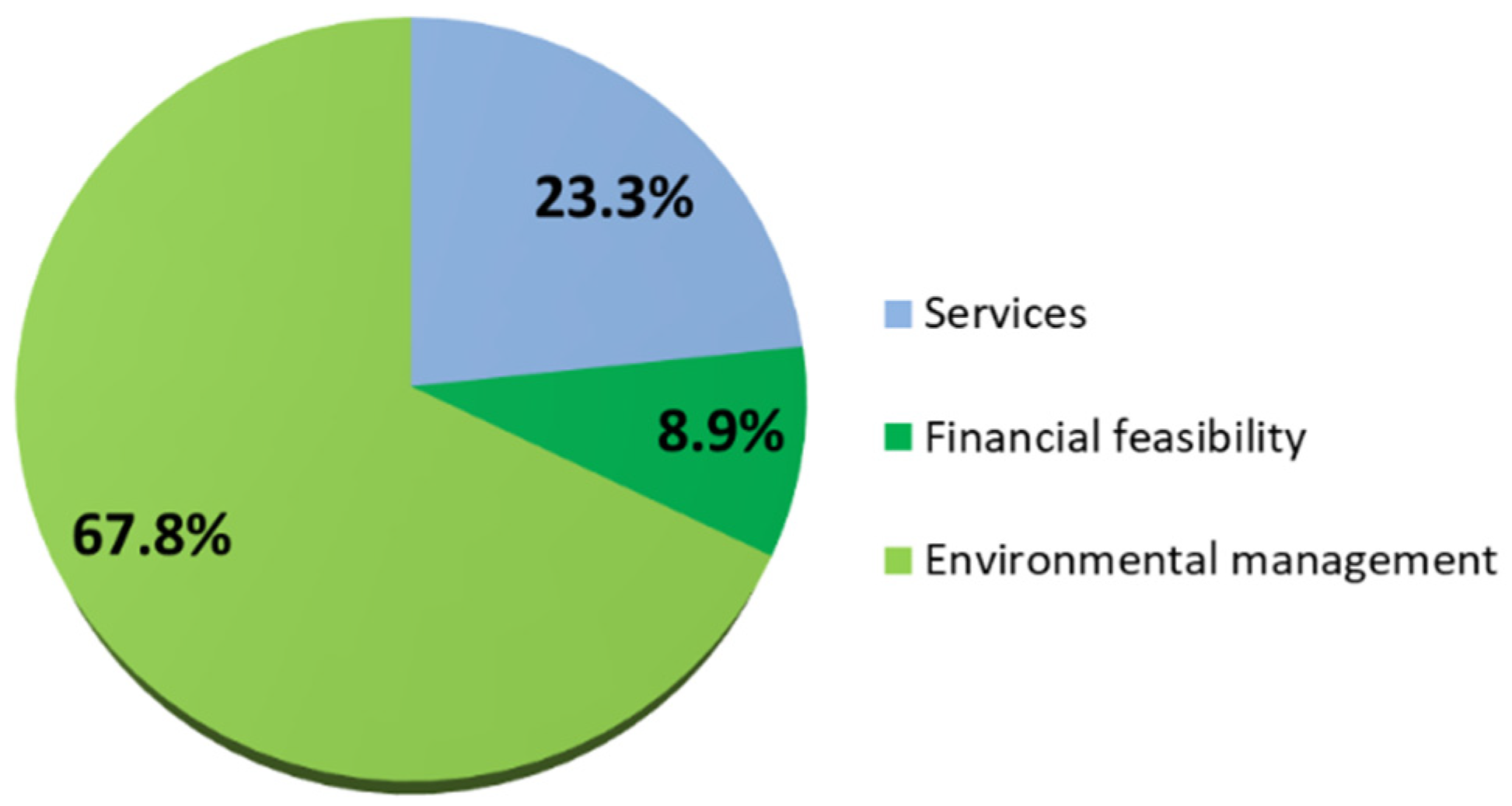
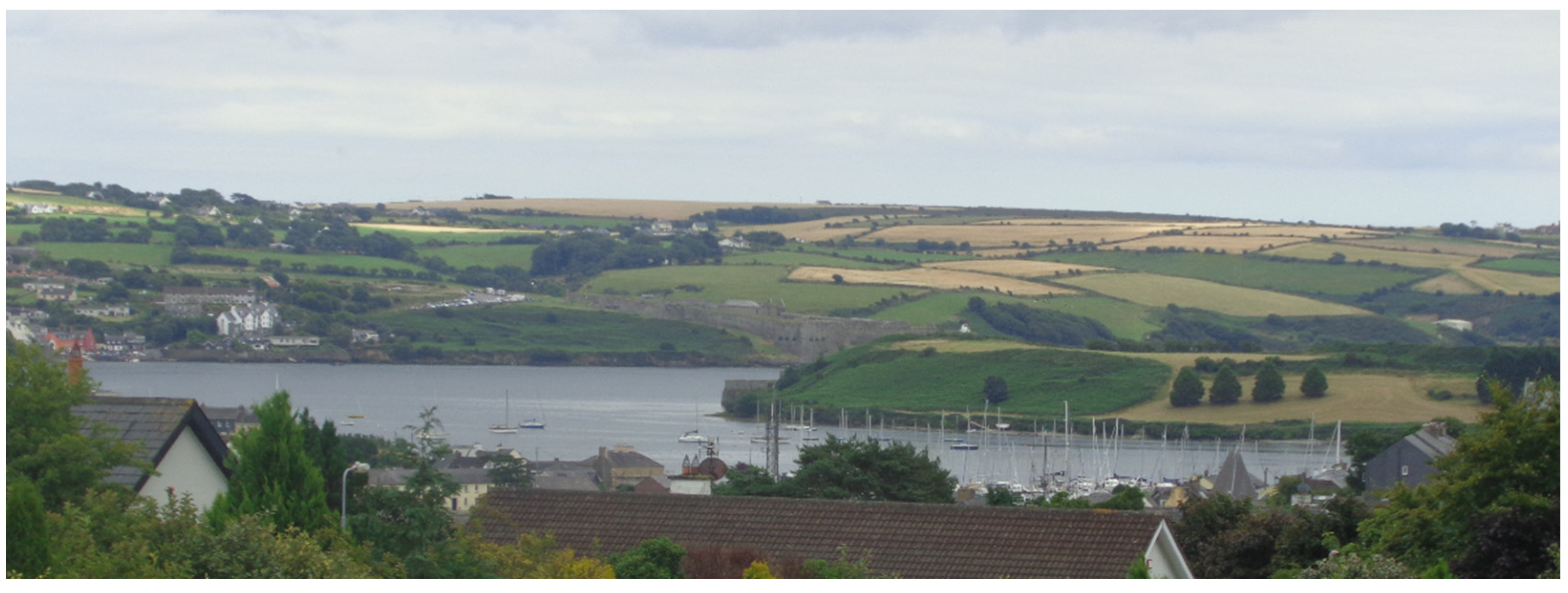

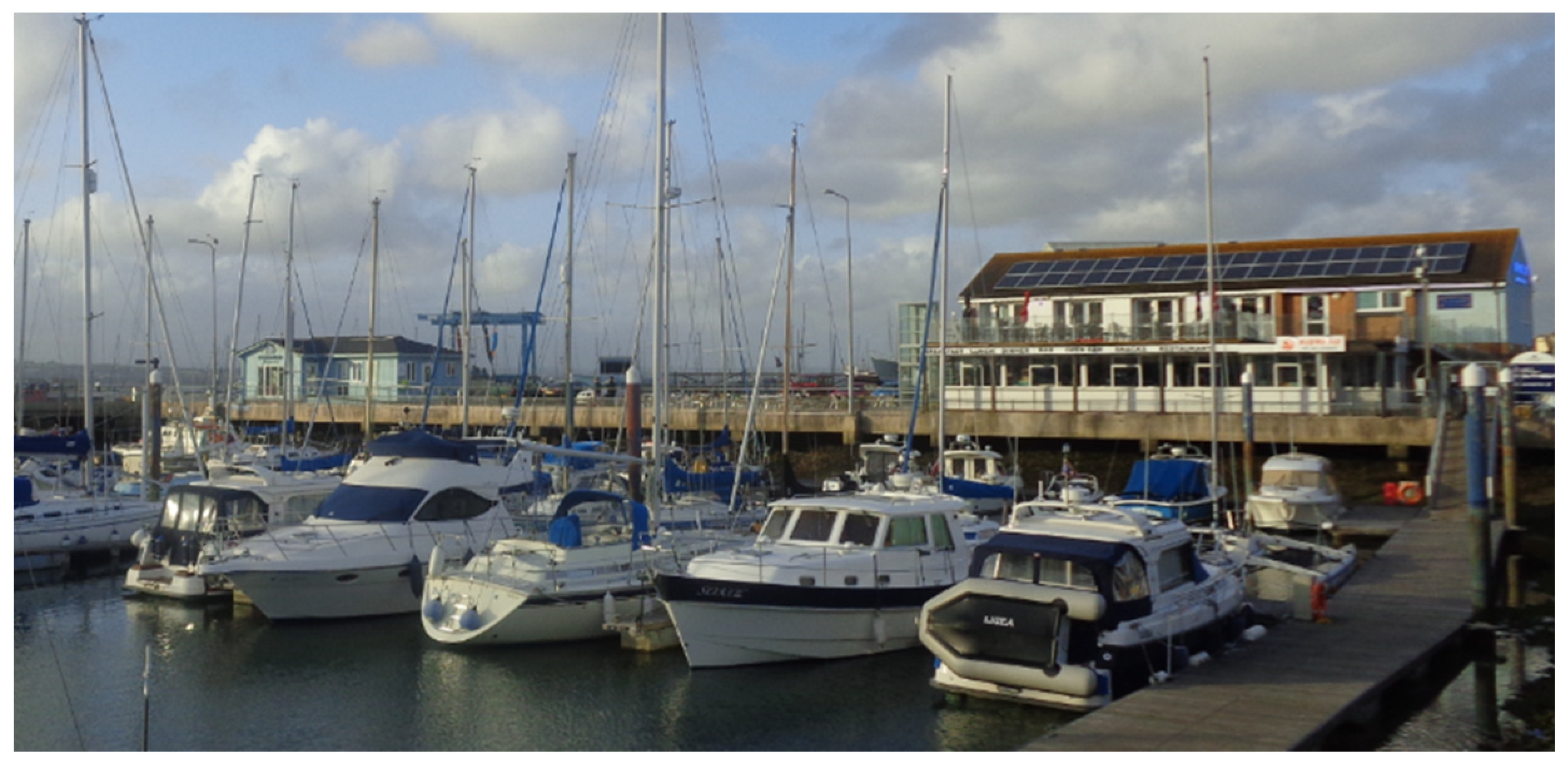
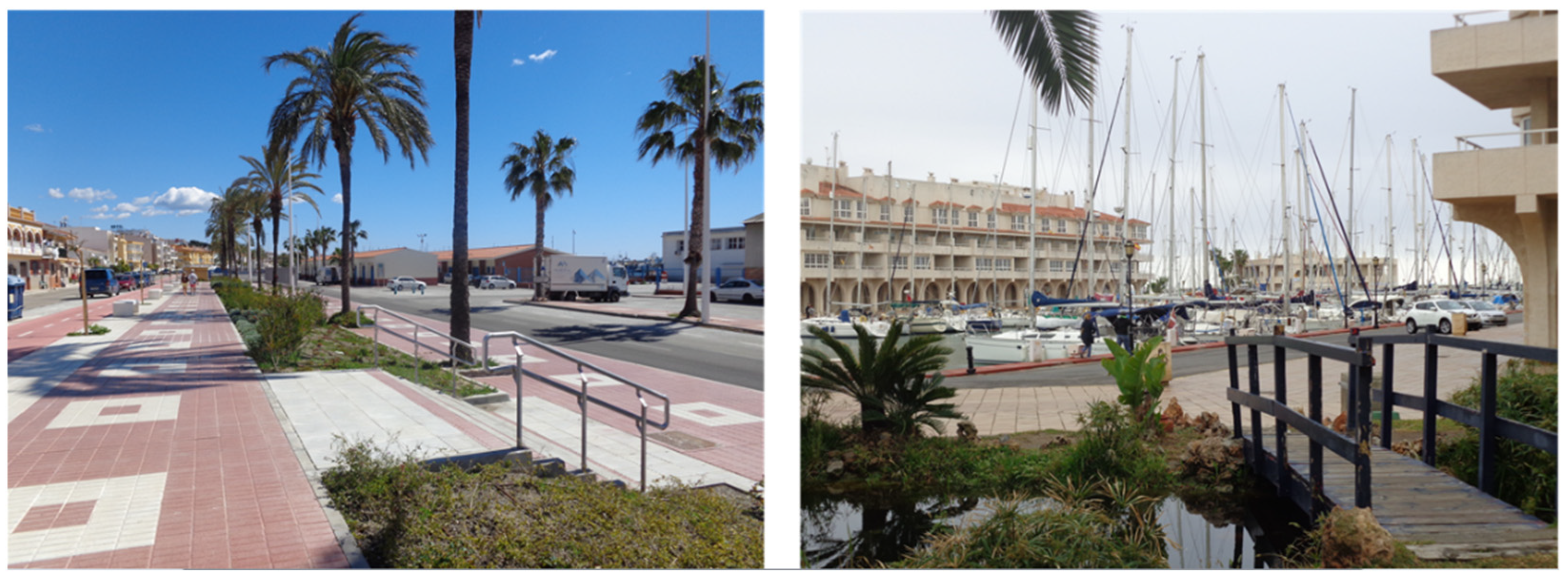
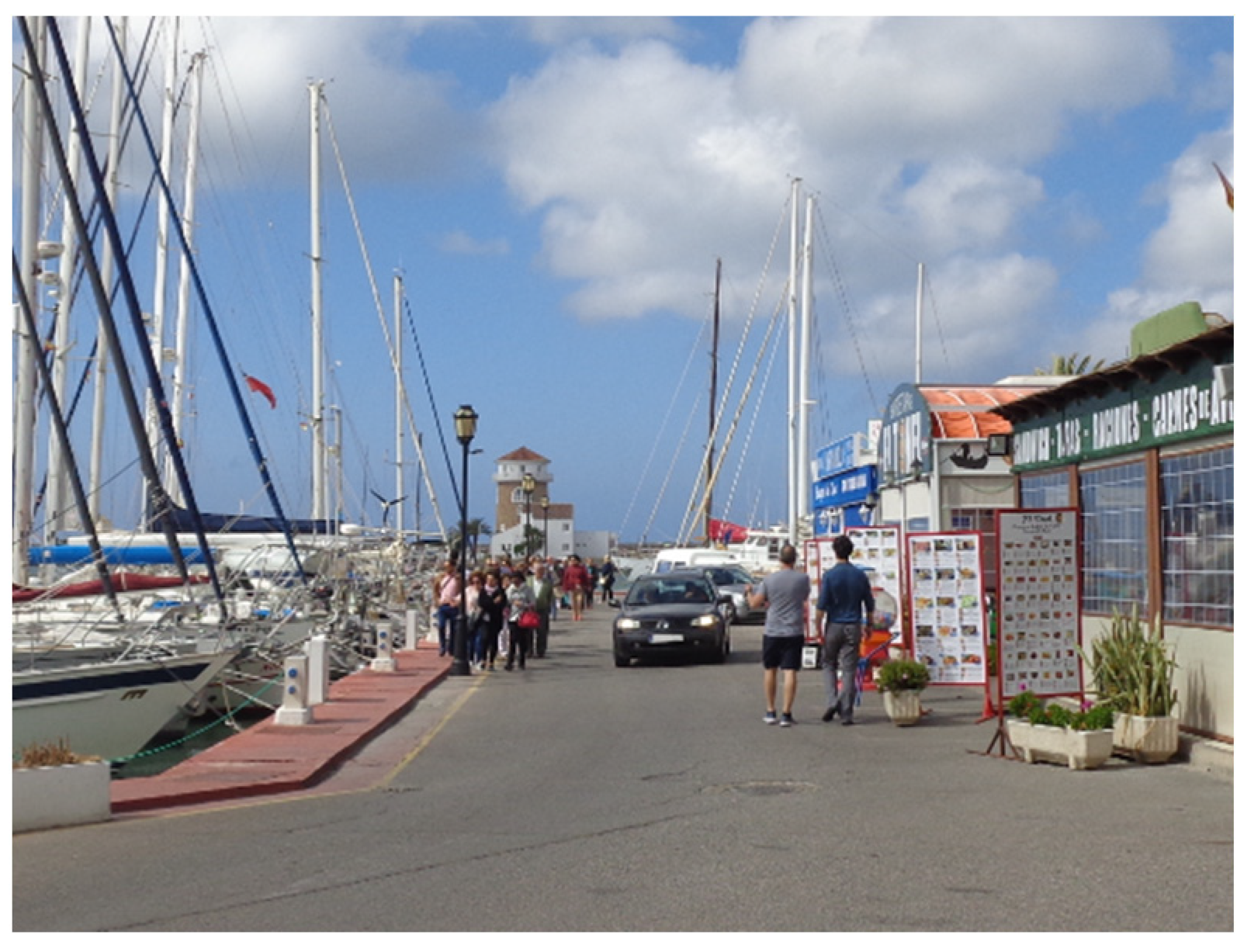
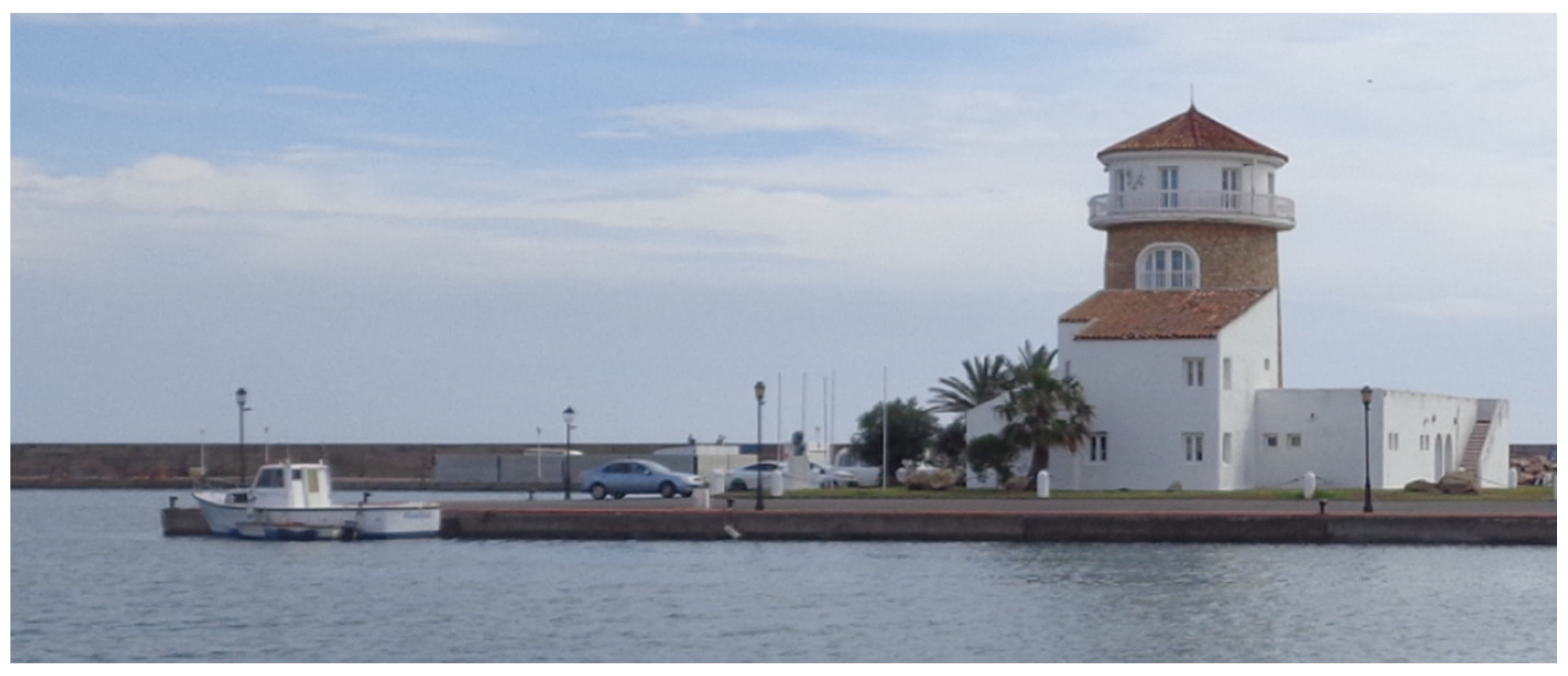
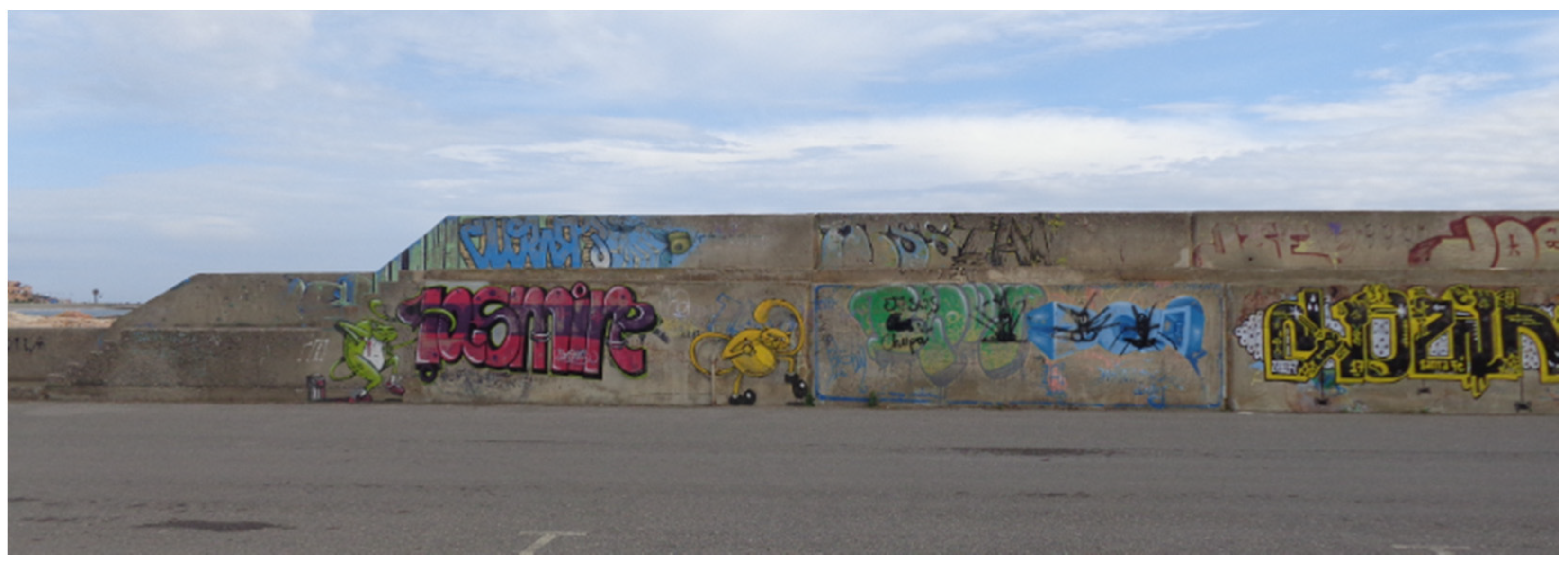
| Type | Description | References |
|---|---|---|
| Marina capacity | Berthing | [18,19,20,21,22,23,24,25] |
| Dry storage | [18,19,20,21,22,24,26,27] | |
| Service facilities | Water supply | [18,19,20,21,22,23,24,25] |
| Bunkering | [18,19,20,21,22,23,24,25,27] | |
| Electrical equipment | [18,19,20,21,22,23,24,25,27] | |
| Sewage, storm water and waste disposal | [18,19,20,21,23,24] | |
| Boat handling | [18,19,20,21,22,23,24,26] | |
| Environmental management | Pollution prevention | [19,22,23,24,25,26,27] |
| Fire protection | [18,19,20,22,23,24,25] | |
| Ice protection | [18,19,24] | |
| Ancillary services | [20,22,24] | |
| Safety and security | [19,20,21,22,23,24] | |
| Landscaping | [20,24] | |
| Buildings | Administration | [18,19,21,24] |
| Social | [18,19,21,24] | |
| Sales and services | [18,19,21,24] | |
| Covered storage | [18,19,24] | |
| Piers and walk structures | [18,19,20,24,27] | |
| Development of grounds | Circulation roads | [18,19,20,24] |
| Parking areas | [18,19,21,22,24] | |
| Boat yards | [18,19,22,23,24,26] | |
| Walks | [18,24] | |
| Financial feasibility | [18,19,20,21,22,23,24,26] | |
| Maintenance | [18,19,20] | |
| Dredging | [18,22] | |
| Staffing and personnel | [18,19,20,21,22,23,24,26,27] | |
| Level of quality/services orientation | [18,21,22,23,24,26,27] | |
| Procedures and regulations | [18,19,20,21,22,23,24] | |
| Liability and insurance | [19,21,22,23,27] |
| Activity | Category | Subject | References |
|---|---|---|---|
| Services | Berths | Berthing capacity | Social |
| Port uses | Boat handling | Physical | |
| Shipyard and boat storage | Physical | ||
| Buildings (direct, indirect and ancillary services) | Physical/social | ||
| Parking facilities | Physical | ||
| Auxiliary elements | Physical | ||
| Mobility | Access | Physical/social | |
| Circulation | Physical/social | ||
| Port services | Supplies (water, electricity, bunkering, etc.) | Physical | |
| Financial feasibility | Social | ||
| Environmental management | Environment | Waste management | Physical/social |
| Environmental compatibility | Physical/social | ||
| Pollution prevention | Physical/social | ||
| Water quality | Physical/social | ||
| Landscaping | Physical/social | ||
| Surroundings | Visual compatibility | Social | |
| Other public agencies’ relationship | Social | ||
| Uses for adjoining land | Social | ||
| Security | Fire protection and prevention | Social | |
| Safety and security | Social | ||
| Maintenance | Physical/social |
Publisher’s Note: MDPI stays neutral with regard to jurisdictional claims in published maps and institutional affiliations. |
© 2021 by the authors. Licensee MDPI, Basel, Switzerland. This article is an open access article distributed under the terms and conditions of the Creative Commons Attribution (CC BY) license (https://creativecommons.org/licenses/by/4.0/).
Share and Cite
Martín, R.; Yepes, V. Bridging the Gap between Landscape and Management within Marinas: A Review. Land 2021, 10, 821. https://doi.org/10.3390/land10080821
Martín R, Yepes V. Bridging the Gap between Landscape and Management within Marinas: A Review. Land. 2021; 10(8):821. https://doi.org/10.3390/land10080821
Chicago/Turabian StyleMartín, Ricardo, and Víctor Yepes. 2021. "Bridging the Gap between Landscape and Management within Marinas: A Review" Land 10, no. 8: 821. https://doi.org/10.3390/land10080821
APA StyleMartín, R., & Yepes, V. (2021). Bridging the Gap between Landscape and Management within Marinas: A Review. Land, 10(8), 821. https://doi.org/10.3390/land10080821








